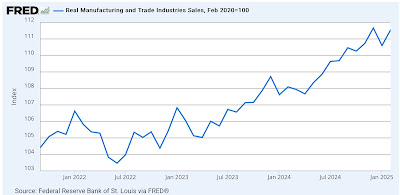Real Personal Income And Spending Tell Us The Consumer Economy Was Expanding Nicely In March
Aside from the long leading indicators I discussed in that post, GDP is a look in the rear view mirror, because it includes January and February. Personal income and spending for March, although it is part of that GDP report, is therefore more current.
Like the housing data we got earlier this week, income and spending told us that the economy was in reasonably good shape through March. The deflator declined by less than -0.1%, rounding to unchanged. Thus both nominal and real readings for income, at +0.5%, and spending, at +0.7%, were the same.
Here is real personal income and spending normed to 100 since the onset of the pandemic, showing the former up 12.3%, and the latter up 15.8%:
(Click on image to enlarge)

An important issue has been whether personal consumption would actually decline in Q1, which was answered in the GDP report. For March, it was an important increase.
Typically it is real spending on goods which declines before recessions, while real spending on services can increase throughout all but the most severe of them. In March both increased to new post-pandemic highs:
(Click on image to enlarge)

Another important but mixed reading was the personal saving rate, which declined -0.2% to 3.9%. This generally indicates consumer confidence, but the downtrend in the past several years makes this rate among the lowest ever. Although not shown, the average between 200 and 2019 was 5%:
(Click on image to enlarge)

Finally, there are several important coincident indicators used by the NBER in recession dating in this report.
First is real personal income less government transfer payments. This increased 0.7% in March:
(Click on image to enlarge)

Second is real manufacturing and trade sales, which are calculated with a one month delay. In February they increased 0.9%, but remain -0.1% below their December 2024 high:

In sum, real personal income and spending in March tells us that despite the negative GDP print, mainly caused by front-running tariffs via a surge in imports, the consumer portion of the US economy remained in expansion.
More By This Author:
JOLTS Report Shows That The “Soft Landing” Was Intact - Through MarchRepeat Home Sales Confirm Deceleration Of Prices For Existing Homes
Regional Fed Manufacturing Indexes Average In April Is Recessionary; Services On The Cusp



